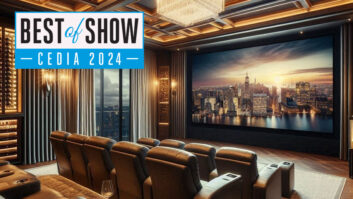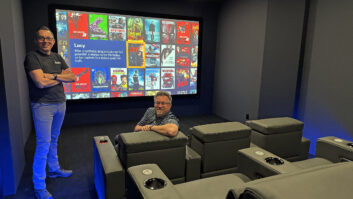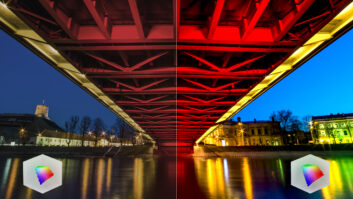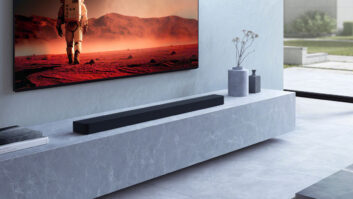When it comes to video, bigger and more is almost always better. But traditional technologies can run into technological limitations when trying to push for those extra inches. Front projection systems, which can be installed with virtually no size limitation, need a seriously light-controlled space. Rear-projection systems require a lot of room. And the mega plasmas — if you can actually get your hands on one of the mythical 150-inch models — weigh a gagillion pounds and practically require their own Tony Stark arc reactor for power.

John Sciacca with the Runco WindowWall in Ft. Lauderdale
I recently traveled to Fort Lauderdale, Florida, to witness Runco’s solution to this problem, a product that they are calling WindowWall and that addresses all of the above limitations – light output, space, weight and power. With WindowWall, Runco is using traditional LCD TV technology (46-inch panels, running 1366 x 768 resolution), with ultra-thin (just .14 inches) bezels that they marry together with other panels through an ingenious mounting system and the processing wizardry of their DHD III controller.
The display that I saw was a 3 x 3 configuration, with a total of nine panels, or “tiles” as Runco calls them. However, Runco general manager Adam Schmidt claims that the system is infinitely scalable, meaning that it could literally fill an entire wall.

Runco WindowWall as a digital canvas
The nine-panel system delivered an overall resolution of 4098 x 2304, producing an image that was 139 inches diagonal (68 high x 122 wide) with 130 foot lamberts. With the micro bezel, there is a scant quarter-inch space between the sets, which very shortly “disappeared” while viewing program material. Also, the entire nine-tile system occupies only 4.5-inches of wall depth and weighs 558 pounds including all mounting hardware.
The WindowWall’s true beauty lies in its complete flexibility for viewing. Want to watch one giant image that fills all nine panels? Feel like nine separate programs? How about one 92-inch diagonal (four panels) program and five other events? WindowWall’s processing allows owners to always keep up with the action they are most interested in.
Schmidt, explained the obvious, “This is a terrific solution for sports fans.” Never before will you have to pick that one game, jump back and forth between channels or suffer with a micro-sized picture-in-picture window. “And,” Schmidt continued, “Say something exciting is happening, like you want to watch Tiger making his charge at The Masters. You can just scale that image up to fill more or the entire screen.”

Feel like nine separate programs or security camera feeds?
Of course it isn’t limited to just broadcast TV, but can also display images from any traditional sources (Blu-ray, DVD, etc.) as well as computers. This makes it an incredibly powerful tool for the well-equipped home office or perfect for multi-tasking during the big game. Imagine spreadsheets spread across multiple windows, a Power Point in another, a four-way video conference the stock ticker and ESPN-HD going all at once.

Imagine spreadsheets spread across multiple windows, a Power Point in another, a four-way video conference the stock ticker and ESPN-HD going all at once.
Installers have also been embracing the WindowWall for something they call the “digital canvas” or “digital ambience” where the panels can display changing works of art, either still or full motion images like waterfalls.
Runco has put a lot of thought into the installation aspects, removing as much hardware from the panels themselves. The result is fan-less, completely silent operation, with the processing and control hardware installed up to 100 feet away and connected via two shielded Cat-6 wire runs. Also, the entire nine-panel array and processing was driven from a single 110-volt power outlet. Another very cool feature is auto color balancing, where every panel “looks” at its immediate neighbors and automatically adjusts for matching color, brightness, and contrast.
The images that I saw were unquestionably terrific, and my head was spinning with installation possibilities. Of course, this awesomeness doesn’t come cheap, with Schmidt explaining that pricing generally runs about $10,000 per tile, or $95,000 for the nine-tile system that I saw. The system is shipping now.
For a “live look” at the Runco WindowWall in action, click on my video footage from the Ft. Lauderdale event, below:







